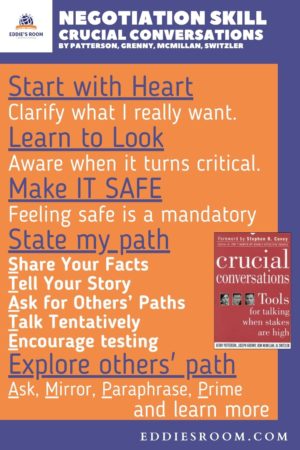You can learn how to engage in dialogue to form a consensus among participants in very critical situations, such as disagreements and strong emotions as seen at home and at work.
Start with Heart
This word reminds me of the importance of clarifying what I really want and what I really don’t want.
Learn to Look
You need to be aware of when casual conversations turn into important conversations. Sometimes the atmosphere changes dramatically by just one word.
When I feel my stomach gets tight or feel scared, hurt, or angry, that’s the timing of the beginning of a crucial conversation.
And I learn that when we feel unsafe, we move to either Silence or Violence.
It is important to understand my style when I feel unsafe or stressed.
Make IT SAFE
Feeling safe is a mandatory condition to have a crucial conversation. In order to make it safe, there are 5 things are described in this book.
1. Step out
Feel safe first and go back to the conversation. If we can’t feel safe, we can’t proceed with any meaningful conversation and stick with silence or violence.
2. Decide which condition of safety is at risk
We have to have Mutual Purpose and Mutual Respect. We need to find out if either is not satisfied.
3. Apologize When Appropriate
We may offend someone if it’s clear we need to apologize to make it a safe condition.
4. Contrast to Fix Misunderstanding
Sometime misundersanding is the reason why the conversation is at risk. So we need to find out if there is any misunderstanding.
We can start with what you don’t intend or mean. Then explain what you do intend or mean.
5. Create a Mutual Purpose
We can use 4 skills to get back to Mutual Purpose.
- Commit to seek Mutulal Purpose.
we have to agree to stay until we will find a solution that satisfies both of us.
- Recognized the purpose behind the strategy.
We can ask “Why do you want that?”
- Invent a Mutual Purpose.
We can’t find a Mutual Purpose, we need to invent one.
- Brainstorm new strategies.
- Once we can identify the Mutual Purpose and then figure out how to achieve it.
Finally, as is the case with most complicated problems, don’t aim for perfrction. Aim for progress.
STATE MY PATH
5 skills with the acronym STATE can be used for sensitive topics.
Share Your Facts
Talk about our experience from our point of view. Firstly talk about the facts then the story.
Tell Your Story
Ask for Others’ Paths
Talk Tentatively
We need to talk with confidence and humility. So some suggestions are described as follows.
- The fact is –> In my opinion
- Everyone knows that –> I’ve talked to three of our suppliers who think that
- It’s clear to me –> I’m beginning to wonder if
Encourage testing
EXPLORE OHTERS’ PATH
There are 4 listening skills with the acronym AMPP. We have to have curiosity and patience to know others.
Ask
Start by simply expressing interest in the other person’s view.
Mirror
Increase safety by respectfully acknowledging the emotions people appear to be feeling
Paraphrase
Restate what you’ve heard to show not just that you understand, but also that it’s safe for them to share what they’re thinking.
Prime
Take our best guess at what they may be thinking and feeling. Prime is a new skill to me!
Thank you for reading this post.
If you want to read this book you can buy it from here.


